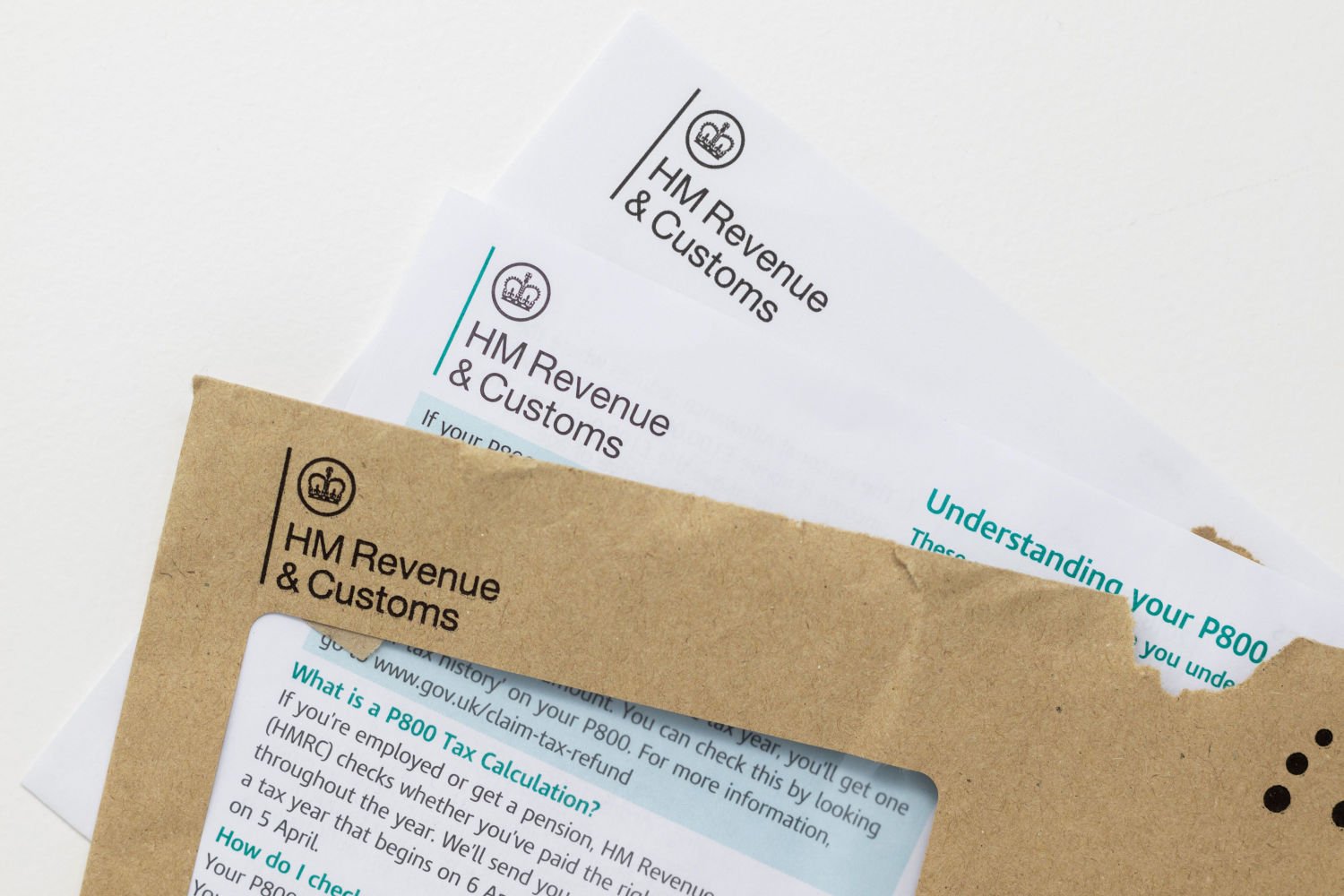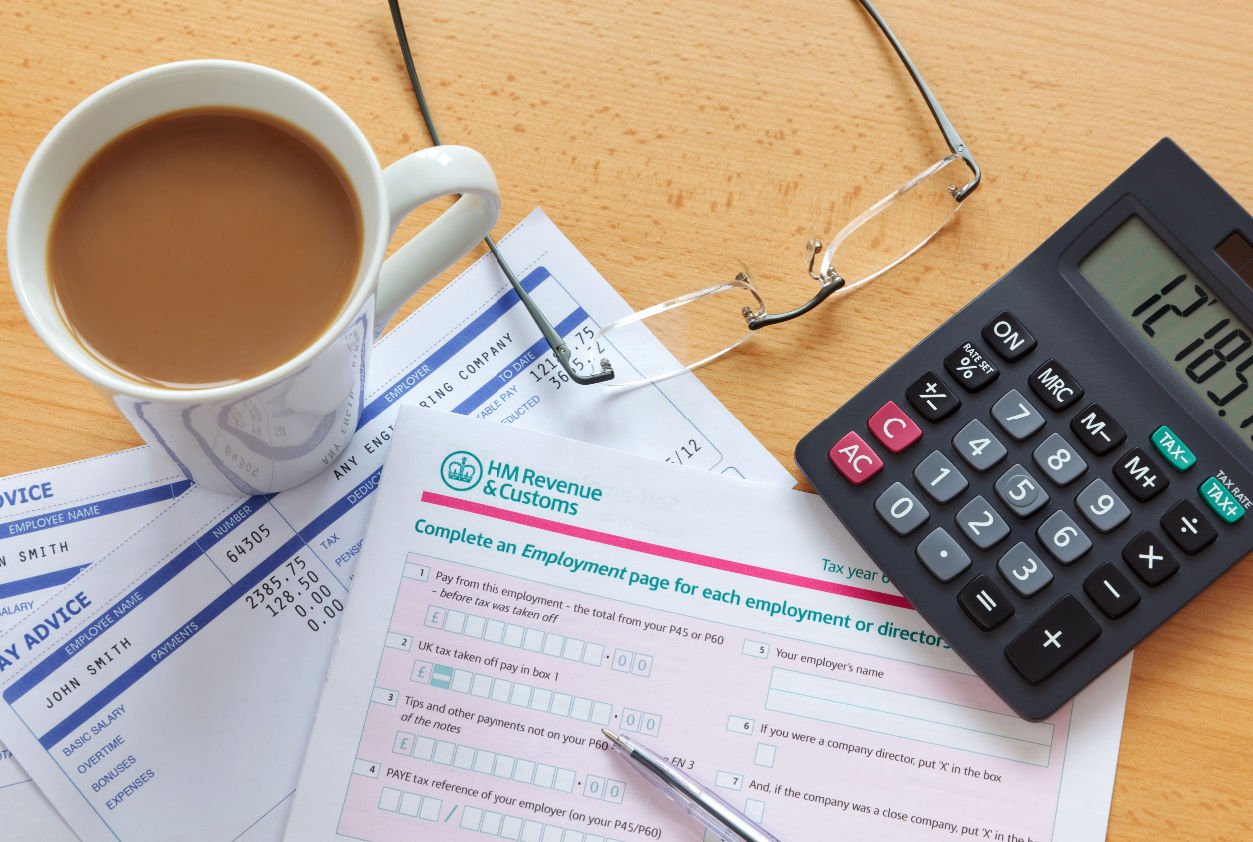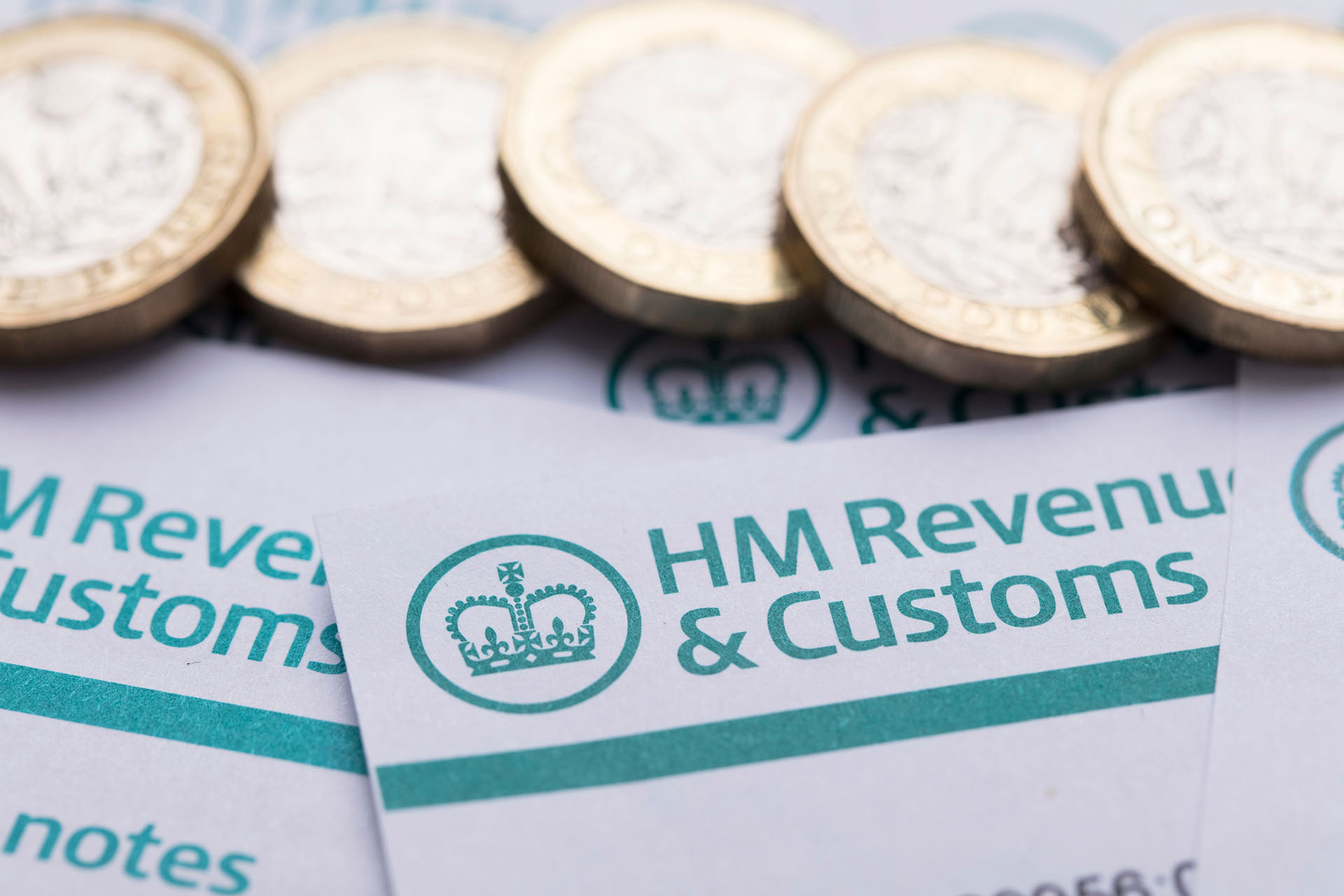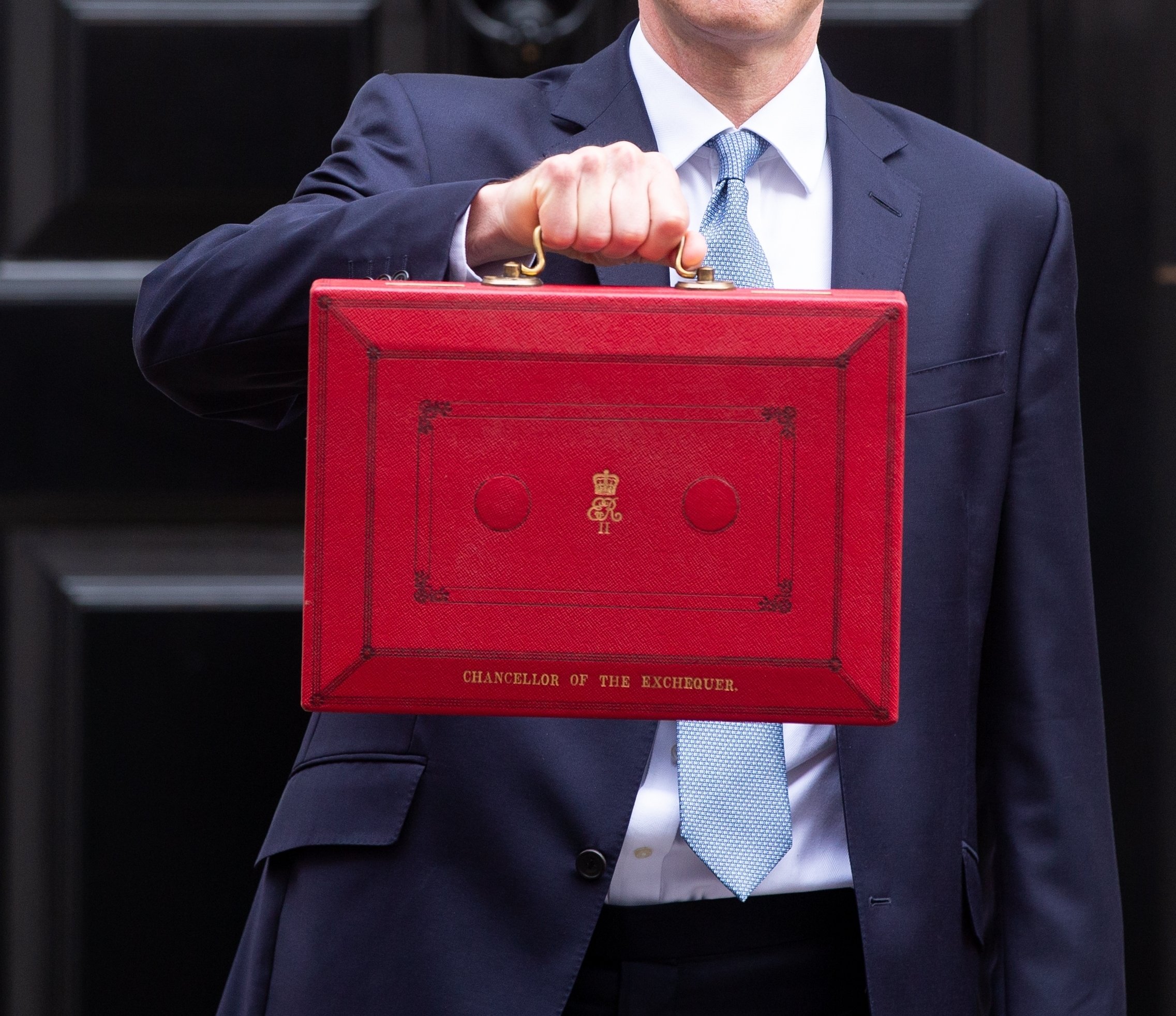UK income tax rates 2025/26: maximise your allowance
When crafting an annual tax plan, for the vast majority of UK taxpayers, income tax considerations will play a pivotal role.
In the 2025/26 tax year, this has been and still is especially true. The government relies on income tax as a major source of revenue, and as global economic conditions change, so too do the challenges and opportunities in tax planning.
Income tax receipts as a proportion of GDP are at their highest level since the 1980s, and with an estimated 400,000 more taxpayers being forced into the 40% income tax band in 2025/26, this level is expected to rise further. The Office for Budget Responsibility (OBR) predicts that seven million people will pay higher-rate tax in 2025-26, representing 2.5 million more taxpayers than if income tax thresholds had never been frozen.
The changes in tax brackets as well as fiscal drag mean that taxpayers need to be increasingly aware of how their earnings are spread across different tax thresholds to minimise liabilities.
As a result, understanding income tax rates and how to minimise your exposure to them in 2025/26 and beyond – for high earners especially – can prove particularly beneficial. It is also wise to consider all available tax planning tools, including options that safeguard both your taxable dividend income and other sources of earnings.
What are the UK income tax rates for 2025/26?
The UK income tax rates for 2025/26 have remained the same as 2023/24 & 2024/25, at 20% for basic rate taxpayers, 40% for higher rate taxpayers and 45% for additional rate taxpayers (except Scotland). Whilst this might seem positive at first, there's more to uncover.
Income Tax Bands in England, Wales and Northern Ireland
2024/25 and 2025/26
|
2024/25 |
2025/26 |
|||
|
|
Bracket |
Rate |
Bracket |
Rate |
|
Personal Allowance |
£0 to £12,570 |
0% |
£0 to £12,570 |
0% |
|
Basic |
£12,571 to £50,270 |
20% |
£12,571 to £50,270 |
20% |
|
Higher |
£50,271 to £150,000 |
40% |
£50,271 to £125,140 |
40% |
|
Additional |
Over £150,00 |
45% |
Over £125,140 |
45% |
*Those earning more than £100,000 will see their Personal Allowance reduced by £1 for every £2 earned over £100,000.
The personal allowance, basic rate threshold and higher rate threshold have remained the same from the 2022/23 tax year, but the additional rate threshold was reduced from £150,000 to £125,140 in the 2023/24 year and has remained the same going into the 2025/26 tax year for the UK including Scotland
Income Tax Bands in Scotland
2024/25 and 2025/26
|
2024/25 |
2025/26 |
|||
|
|
Bracket |
Rate |
Bracket |
Rate |
|
Personal allowance |
£0 to £12,570 |
0% |
£0 to £12,570 |
0% |
|
Starter Rate |
£12,571 to £14,876 |
19% |
£12,571 to £15,397 |
19% |
|
Scottish basic Rate |
£14,877 to £26,561 |
20% |
£15,398 to £27,491 |
20% |
|
Intermediate Rate |
£26,562 to £43,662 |
21% |
£27,492 to £43,662 |
21% |
|
Higher Rate |
£43,663 to £75,000 |
42% |
£43,663 - £75,000 |
42% |
|
Advanced Rate |
£75,001 - £125,140* |
45% |
£75,001 - £125,140* |
45% |
|
Top Rate |
Above £125,140* |
48% |
Above £125,140* |
48% |
*Those earning more than £100,000 will see their Personal Allowance reduced by £1 for every £2 earned over £100,000.
The Starter rate band has increased by 22.6%, and the Basic rate band has risen by 6.6%, raising the thresholds for both the Basic and Intermediate tax rates by 3.5%.
Meanwhile, the Higher, Advanced, and Top rate thresholds remain frozen until 2026-27. The UK-wide Personal Allowance has stayed at £12,570, as confirmed in the 2024 Autumn Statement.
How are taxpayers being affected?
The reduced additional income tax threshold of £125,140, introduced across the UK in 2022/23, has significantly increased the tax burden for high earners. Previously set at £150,000, the £24,860 reduction has pushed an additional 250,000 taxpayers into the 45% additional tax bracket. This change increases the portion of earnings subject to higher tax rates on both employment and dividend income.
For individuals earning £150,000 or more, the long-term impact is particularly erosive. In 2025/26, a taxpayer in England, Wales, or Northern Ireland earning £150,000 will pay 45% tax on £24,860 of their income.
Whilst lowering thresholds hasn't been a new issue for UK taxpayers going into 2025/26, periods of higher inflation, income tax bands and allowances frozen until 2028 and high wage growth have been.
With year's of 6% average wage growth, an individual earning £150,000 in 2023/24 would see their salary rise to £159,000 in 2024/25, meaning an additional £9,000 is taxed at 45%, adding £4,050 in extra tax. Continuing this trend into 2025/26, the same taxpayer could see their salary increase further to £168,540, with an additional £9,540 taxed at 45%, leading to an extra £4,293 in tax. Over time, these effects have and will compound, making fiscal drag an increasingly pressing issue.
It's also worth noting that whilst real wage growth is now positive (meaning that wage growth is outpacing inflation) in the year too December 2022, wages were again rising roughly 6% contributing again to fiscal drag. As well as this, in that year Real wage growth was -2.8%. This means that as well as paying more income tax due to fiscal drag, wages would be getting less and less effective due to inflation.
Example of fiscal drag from 2022/23 with a salary of £150,000
|
Year |
Salary |
Extra Tax |
|
2022/23 |
£150,000 |
£0 |
|
2023/24 |
£159,000 |
£4050 |
|
2024/25 |
£168,540 |
£4293 |
|
2025/26 |
£178,652 |
£4,550 |
|
Increase |
£28,652 |
£12,893 |
With the minimum wage set to rise again in April 2025, it will be important to see how wage growth and inflation respond. If both increase, some of the challenges seen in December 2022—such as higher taxes due to fiscal drag and reduced purchasing power—could resurface.
In summary, the trajectory is clear. With wage growth continuing, tax thresholds remaining frozen, and inflation potentially persisting, fiscal drag shows no signs of easing. This issue affects not just high earners but anyone subject to income tax.
It’s important to note that these adjustments can also affect any dividend income received, which may subsequently be taxed at higher rates.
While this may seem like a relatively small increase, investing an extra £4,500 per year, for example, could have a significant impact on long-term personal finances. As wages continue to rise, more people will be affected by this higher tax rate in the coming years, not only through income tax on employment earnings but also on dividend income and other revenue streams.
Are there any allowances available to reduce my income tax liability in 2025/26?
In the UK, individuals can make use of several tax-free allowances each year. Spanning taxes from income tax to capital gains tax, utilising these together can help to minimise annual tax liabilities. Some of the most significant include:
- Personal allowance: In the UK, taxpayers are entitled to a personal allowance, which is the level of annual income they can earn before they start paying income tax. For the 2025/26 tax year, the personal allowance is £12,570. For every £2 earned over £100,000, taxpayers lose £1 from their personal allowance (which is then taxed at the 40% rate). This means that all taxpayers with an income over £125,140 do not receive the personal allowance. Looking into salary sacrifice schemes can be a great option when earning between £100,000 and £125,140, where individuals might be able to reduce their taxable income—and by extension, maintain greater tax efficiency on both their salary and dividend income.
- Capital gains tax allowance: Individuals can realise profits on the sale of assets such as shares and property up to a certain level each year free of capital gains tax. In 2025/26 this allowance is £3,000, less than a quarter from 2022/23’s figure of £12,300.
- Dividend allowance: Individuals can earn up to £500 in dividends annually – free of dividend tax – as of the 2025/26 tax year. This allowance applies to dividend income from various sources and is a quarter of 2022/23’s figure of £2,000.
- ISA allowance: The level of capital an individual can contribute to an ISA each tax year without paying tax on interest, dividends, or capital gains is £20,000 in 2025/26. This can be split across four types of ISAs – Cash ISAs, Stocks and Shares ISAs, Innovative Finance ISAs (IFISAs) and Lifetime ISAs – or allocated solely to one ISA.
Which reliefs & schemes can I use to minimise my income tax liability in 2025/26?
Alongside the tax-free allowances individuals can make use of, a number of reliefs and schemes can be accessed to further minimise income tax liabilities. With tax-free allowances being gradually reduced and cut by the UK government – for high earners especially – understanding how to make use of these tools is becoming increasingly essential.
1. Enterprise Investment Scheme (EIS)
The Enterprise Investment Scheme (EIS) is a tax-efficient venture capital scheme that offers individuals a generous range of tax incentives when investing in early-stage companies.
One of the most attractive tax incentives offered by the EIS is 30% income tax relief. This relief enables an investor to claim back up to 30% of the sum they invest into the EIS from their income tax bill of the current or previous tax year.
With the annual EIS investment maximum standing at £1 million in 2025/26 (or £2m should everything over £1m be invested into knowledge-intensive companies [KICs]), this can enable taxpayers to claim annual income tax relief of up to £600,000, ultimately reducing the overall tax liability on both employment earnings and other revenue streams.
2. Seed Enterprise Investment Scheme (SEIS)
The Seed Enterprise Investment Scheme (SEIS), is the 'younger sibling' of the EIS. Introduced in 2012, it facilitates investment specifically into especially early-stage startups, and in turn, offers investors even more generous tax reliefs to offset the added risk this can bring.
The headline SEIS tax incentive is 50% income tax relief on the amount invested (up to £200,000 annually, following changes that came into effect in April 2023).
Alongside this income tax relief, the EIS and SEIS offer investors capital gains tax exemption, capital gains tax deferral/reinvestment relief, inheritance tax exemption and loss relief. For individuals with considerable tax bills, this can make the schemes especially attractive in 2025/26.
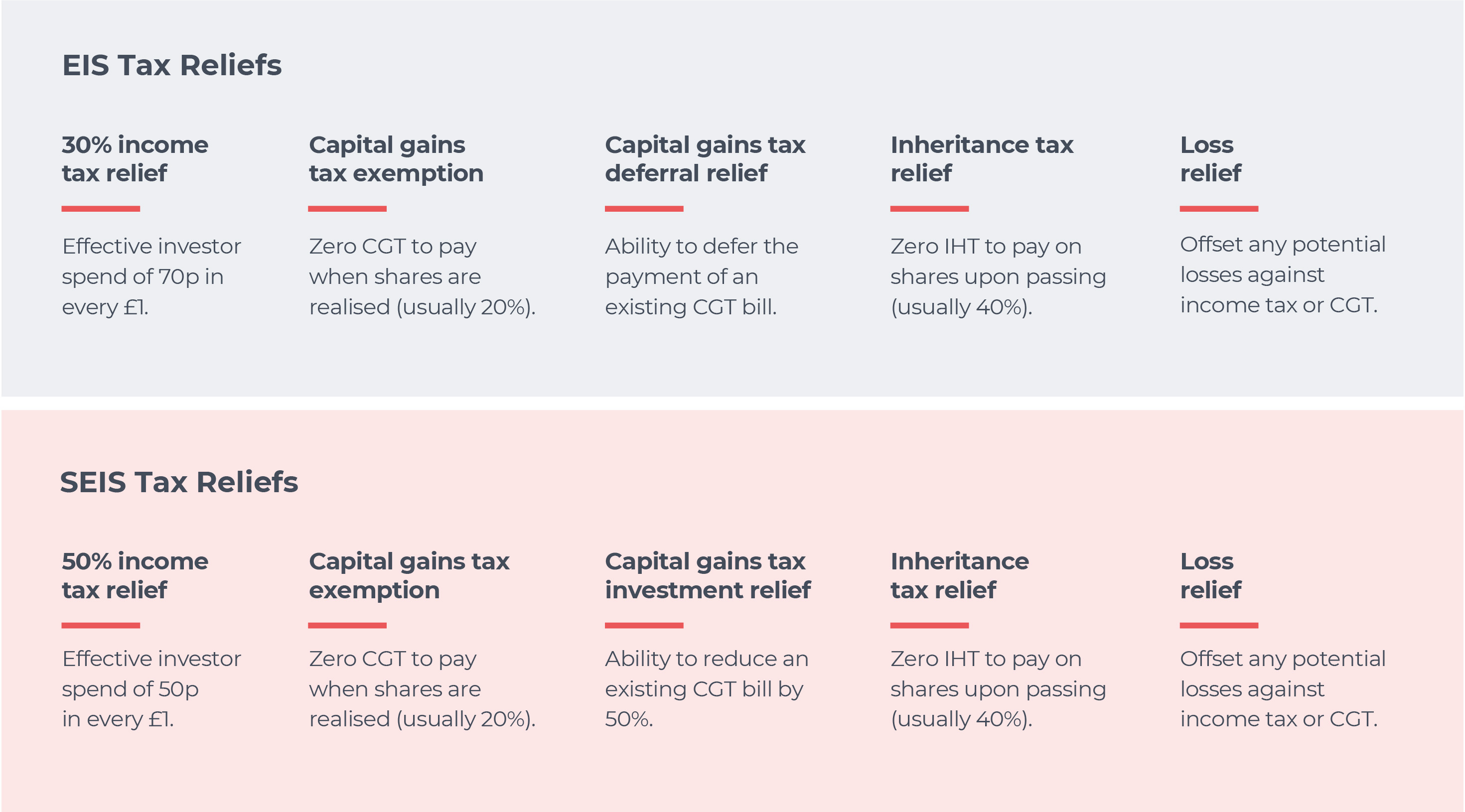
3. Venture Capital Trusts (VCTs)
VCTs are investment trusts that pool investor capital to invest in a collection of small to medium-sized companies on the investors' behalf and with the advantage of several added tax reliefs. VCTs offer 30% income tax relief up to a maximum investment of £200,000 per year, though their tax advantages are not as extensive as those of the EIS and SEIS. While VCTs might help reduce your overall tax liability, investors should also consider the impact on national insurance contributions when evaluating their total tax position.
4. Individual Savings Accounts (ISAs)
Individual Savings Accounts (ISAs) allow investors to save and/or invest money without paying tax on any interest or capital gains earned. The annual ISA allowance for the 2025/26 tax year is £20,000. Investors can allocate this allowance across the full ISA family, including the Cash ISA, Stocks and Shares ISA, Innovative Finance ISA and Lifetime ISAs.
Access: Free Guide to Tax Efficient Investing
5. Pension Contributions
In the UK, income tax relief is available on contributions to pension schemes. Basic-rate taxpayers can receive 20% tax relief, while higher-rate and additional-rate taxpayers can receive 40% and 45% respectively. Investors can contribute up to 100% of their earnings to a pension scheme, subject to an annual allowance of £60,000 for the tax year 2025/26. In addition to regular pension contributions, it’s worth exploring options such as transferring unused allowances from a partner through the marriage allowance, which can further enhance your overall tax position. Individuals looking to invest using their pension can make use of an additional range of tax advantages via both personal schemes and occupational schemes set up by employers. Popular examples of these include Self Invested Personal Pensions (SIPPs) and Small Self Administered Schemes (SSAS).
6. Salary sacrifice schemes
Salary sacrifice schemes (SSS) are arrangements where an employee agrees to reduce their salary in exchange for non-cash benefits. This helps lower taxable income, thereby reducing income and National Insurance contributions whilst making individuals less sesetable to income tax rate changes. Unlike investment schemes like the Enterprise Investment Scheme (EIS) or Seed Enterprise Investment Scheme (SEIS), which provide tax relief on investments, salary sacrifice schemes directly reduce taxable income. They also indirectly control how much of your earnings spill over into higher tax thresholds and tax brackets.
Options within Salary Sacrifice Schemes:
- Pension Contributions: Sacrificing part of your salary to contribute to a pension scheme offers tax efficiencies and boosts retirement savings.
- Childcare Vouchers: Available to existing members, this option helps cover childcare costs (closed to new applicants).
- Cycle to Work Scheme: Employees can lease a bike and safety equipment, promoting healthier commuting while reducing taxable income.
- Car Leasing: Some employers offer schemes for leasing cars, including electric vehicles, such as the Octopus Energy SSS, which reduces taxable income.
- Technology Schemes: Sacrifice salary in exchange for tech products like laptops and smartphones, often at a reduced cost.
- Holiday Schemes: Some employers allow employees to sacrifice salary for planned holidays.
As these schemes reduce both income tax and National Insurance contributions, they are increasingly popular.
However, it’s important to note that relying solely on SSS for tax planning can be risky. With rising popularity, government intervention is probable, and to secure revenue, the government may adjust or limit salary sacrifice policies if they see significant reductions in taxable income.
Forming an income tax plan in 2025/26 and beyond
When crafting an income tax plan, it’s important to consider various strategies to optimise your tax position. Combining different tax relief options, such as the Enterprise Investment Scheme (EIS) or Seed Enterprise Investment Scheme (SEIS), with other methods can create a more comprehensive approach to managing tax liabilities. For example, salary sacrifice can reduce taxable income and EIS can provide valuable income tax relief on investments, ensuring a robust strategy for tax reduction while managing both earnings and dividend income.
The most appropriate tax strategy for any individual will depend on their unique circumstances. As income tax rules become stricter and tax-free allowances remain frozen, taxpayers will need to explore more effective ways to reduce their liabilities—whether through utilising relatively straightforward tools like the marriage allowance or employing complex portfolios of tax-efficient investment options. For some, utilising the UK’s tax-free allowances may be sufficient.
However, those with higher income tax bills may need to consider additional tools to minimise their exposure, ensuring that all thresholds and brackets are optimally managed.
Tax-efficient investment options, such as EIS and SEIS, offer generous income tax relief, while pension schemes like SIPPs and SSASs provide additional tax advantages on pension contributions. The right strategy will vary depending on each taxpayer’s goals and financial situation. In this dynamic and increasingly high tax environment, it will be crucial to manage revenue, earnings, and dividend income effectively while also considering national insurance and tax brackets.
As tax rules continue to evolve, staying informed about the latest changes and the full range of available tax-efficient tools will be crucial. Effective income tax planning for 2025/26 and beyond requires a proactive, well-informed approach to ensure the right strategies are employed to minimise liabilities and maximise available benefits.
GCV Invest is an FCA authorised co-investment platform and private investor network. We do not offer financial or tax advice. Individuals should seek professional advice from a qualified adviser prior to investing.
%20(3)%20(2).jpg)
